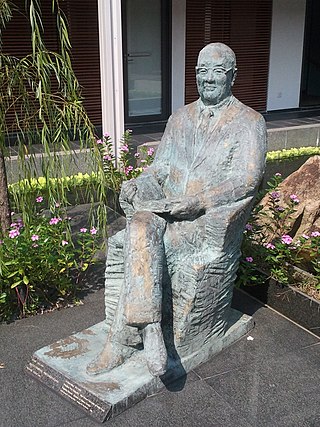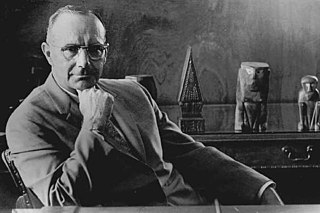
United Nations Relief and Rehabilitation Administration (UNRRA) was an international relief agency, largely dominated by the United States but representing 44 nations. Founded in November 1943, it was dissolved in September 1948. it became part of the United Nations in 1945. Its purpose was to "plan, co-ordinate, administer or arrange for the administration of measures for the relief of victims of war in any area under the control of any of the United Nations through the provision of food, fuel, clothing, shelter and other basic necessities, medical and other essential services". Its staff of civil servants included 12,000 people, with headquarters in New York. Funding came from many nations, and totalled $3.7 billion, of which the United States contributed $2.7 billion; Britain, $625 million; and Canada, $139 million.
China is one of the charter members of the United Nations and is one of five permanent members of its Security Council.

Li Choh-ming was a Chinese-born American economist and educator. He was the founding Vice-Chancellor of the Chinese University of Hong Kong in 1963. He compiled The Li Chinese Dictionary (Cantonese-Mandarin). He was an economics professor at the University of California, Berkeley and at Nankai University in Tiensien during his academic career.
David Weintraub (1904–1969) was an official of the government of the United States. In the mid-1930s he headed the New Deal Works Project Administration's National Research Project. In the 1940s Weintraub moved to the United States Department of State, becoming head of the Office of Foreign Relief and Rehabilitation Operations. He joined the professional staff of the United Nations Relief and Rehabilitation Administration (UNRRA) and United Nations Division of Economic Stability and Development.
George Nikolas Perazich was born in the Principality of Montenegro.

Seagoing cowboys is a term used for men and ships used from 1945 to 1947 for United Nations Relief and Rehabilitation Administration and the Brethren Service Committee of the Church of the Brethren that sent livestock to war-torn countries. These seagoing cowboys made about 360 trips on 73 different ships. Most of the ships were converted World War II cargo ships with added cages and horse stalls. The Heifers for Relief project was started by the Church of the Brethren in 1942; in 1953 this became Heifer International. In the wake of the destruction caused by the Second World War, the historical peace churches in the United States sponsored relief missions to war-ravaged Europe, typically in cooperation with the United Nations Relief and Rehabilitation Administration (UNRRA). These relief missions usually took the form of transporting farm animals, by transatlantic ship, to Poland and other countries where much of the livestock had been killed in the war. The men who tended the animals aboard these boats were called seagoing cowboys. These ships moved horses, heifers, and mules as well as chicks, rabbits, and goats. Ten seagoing cowboys died on the SS Park Victory when it sank after accidental grounding in the Gulf of Finland on December 25, 1947.
Ruth Rifkin was an American who worked for the predecessor agency which later became the United Nations Relief and Rehabilitation Administration (UNRRA) during World War II. Rifkin also was a source for Golos-Bentley network of spies that worked for Soviet intelligence and was engaged in espionage on behalf of the Soviet Union.
Samuel Jacob Rodman, was an American double agent during World War II. Rodman was employed by the United Nations Relief and Rehabilitation Administration (UNRRA) and spied for the Soviet Union at the same time. Rodman was a member of the Communist Party of the United States (CPUSA), and his previous occupations were teaching and journalism.

The Liberation Class was a class of 2-8-0 steam locomotives designed for heavy freight work in post-Second World War Europe. 120 were built by the Vulcan Foundry of Newton-le-Willows in 1946.
Sir Robert Gillman Allen Jackson, was an Australian naval officer, public servant and United Nations administrator who specialised in technical and logistical assistance to the developing world.

Seeds of Destiny is a 1946 short propaganda film about the despairing situation faced by millions of children in the wake of the Holocaust who were homeless, parentless, orphaned, and in poor health. The film was produced by the Defense Department of The U.S. Army War Department to keep the world's attention focused on the suffering of displaced and orphaned refugee children in transit and displaced persons camps in Europe and to champion the work of UNRRA. It was the winner of the Oscar for Best Documentary Short Subject in 1946. It was directed by accomplished short film — and later feature film — director David Miller.
Sir Frederick William Leith-Ross, GCMG, KCB was a Scottish economist who was chief adviser to the UK government from 1932 to 1945.
United States foreign aid, also known as US foreign assistance consists of a variety of tangible and intangible forms of assistance the United States gives to other countries. Foreign aid is used to support US national security and commercial interests and can also be distributed for humanitarian reasons. Aid is financed from US taxpayers and other revenue sources that Congress appropriates annually through the United States budget process. It is dispersed through "over 20 U.S. government agencies that manage foreign assistance programs," although about half of all economic assistance is channeled through the United States Agency for International Development (USAID).
Florence Nellie Udell, CBE, RGN, SRN, FRSH, FSCM was a British nurse, nursing administrator and government official.

Tillson Lever Harrison was a Canadian physician, army officer and adventurer. Moving to New York and enlisting in the United States Army at an early age, he later returned to Canada to attend the University of Toronto before practising as a physician in a number of dangerous positions, such as the Chief of Medical Staff to Pancho Villa and the doctor for the Chinese Labour Corps, a workforce of over 200,000 men. After World War I, he traveled throughout the Middle East, treating venereal disease and operating an X-ray facility in Lod, Israel.

Delmas Henry Nucker was an American government official who served as High Commissioner of the Trust Territory of the Pacific Islands from September 1, 1954 to May 1, 1961.

The Dupont Circle Building is a landmark art deco building on the south end of Dupont Circle in Washington DC. The entrance is on 1350 Connecticut Avenue NW.

U.N.R.R.A. presents In the Wake of the Armies ... is a 13-minute 1944 Canadian documentary film, made by the National Film Board of Canada (NFB) for the United Nations Relief and Rehabilitation Administration (UNRRA), as part of the wartime Canada Carries On series. The film, directed by Guy Glover, described the work of the UNRRA during the Second World War and Canada's role in the relief agency. The film's French version title is À la suite de nos armées viendra l'entraide.

The SS Gainesville Victory was the 22nd Victory ship built during World War II under the Emergency Shipbuilding program. She was launched by the California Shipbuilding Company on June 9, 1944, and completed on July 22, 1944. The ship’s United States Maritime Commission designation was VC2-S-AP3, hull number 22 (V-22). She was operated by the Seas Shipping Company. SS Gainesville Victory served in the Pacific Ocean during World War II. SS Gainesville Victory was number one of the new 10,500-ton class of ships, known as Victory ships. Victory ships were designed to replace the earlier Liberty Ships. Liberty ships were designed to be used just for WW2, while Victory ships were designed to last longer and serve the US Navy after the war. The Victory ships differed from the Liberty ships in that they were faster, longer, wider, taller, had a thinner stack set farther toward the superstructure, and had a long raised forecastle.
The Office of Foreign Relief and Rehabilitation Operations (OFRRO) was a short-lived organization created during World War II in the United States Department of State. It existed between December 1942 and November 1943, when it was replaced by the United Nations Relief and Rehabilitation Administration (UNRRA).










